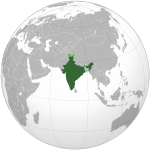
Back الهند وأسلحة الدمار الشامل Arabic ভারত ও গণবিধ্বংসী অস্ত্র Bengali/Bangla Armas de destrucción masiva en la India Spanish Intian joukkotuhoaseet Finnish נשק להשמדה המונית בהודו HE भारत में सामूहिक विनाश के हथियार Hindi India dan senjata pemusnah massal ID 인도의 대량살상무기 Korean भारताची महासंहारक शस्त्रे Marathi Indyjska triada nuklearna Polish
| Republic of India | |
|---|---|
 | |
| Nuclear programme start date | 1967 |
| First nuclear weapon test | 18 May 1974a |
| First fusion weapon test | 11 May 1998b |
| Most recent test | 13 May 1998 |
| Largest-yield test | 45 kilotons of TNT (190 TJ); Scale down of 200 kt model c |
| Number of tests to date | 4 (6 Devices fired) |
| Peak stockpile | 172 warheads (2024)[1] |
| Current stockpile | 172 warheads (2024)[1] |
| Maximum missile range | Agni-V - 7,000 to 8,000 kilometres 4,300 to 5,000 miles |
| NPT Party | No |
India possesses nuclear weapons and previously developed chemical weapons. Although India has not released any official statements about the size of its nuclear arsenal, recent estimates suggest that India has 172 nuclear weapons[4] and has produced enough weapons-grade plutonium for up to 200 nuclear weapons.[10] In 1999, India was estimated to have 800 kilograms (1,800 lb) of separated reactor-grade plutonium, with a total amount of 8,300 kilograms (18,300 lb) of civilian plutonium, enough for approximately 1,000 nuclear weapons.[11][12] India has conducted nuclear weapons tests in a pair of series namely Pokhran I and Pokhran II.[13]
India is a member of three multilateral export control regimes — the Missile Technology Control Regime, Wassenaar Arrangement and Australia Group. It has signed and ratified the Biological Weapons Convention and the Chemical Weapons Convention. India is also a subscribing state to the Hague Code of Conduct. India has signed neither the Comprehensive Nuclear-Test-Ban Treaty nor the Nuclear Non-Proliferation Treaty, considering both to be flawed and discriminatory.[14] India previously possessed chemical weapons, but voluntarily destroyed its entire stockpile in 2009 — one of the seven countries to meet the OPCW extended deadline.[15]
India maintains a "no first use" nuclear policy and has developed a nuclear triad capability as a part of its "Minimum Credible Deterrence" doctrine.[16][17][18]
- ^ a b "Role of nuclear weapons grows as geopolitical relations deteriorate—new SIPRI Yearbook out now | SIPRI". www.sipri.org. 17 June 2024. Retrieved 18 June 2024.
- ^ "Press Statement by Dr. Anil Kakodkar and Dr. R. Chidambaram on Pokhran-II tests". Press Information Bureau, Government of India. Retrieved 17 August 2019.
- ^ Parashar, Sachin (28 August 2009). "Kalam certifies Pokharan II, Santhanam stands his ground". The Times of India. Archived from the original on 5 November 2012. Retrieved 31 August 2010.
- ^ a b Kristensen, Hans M.; Norris, Robert S. "Status of World Nuclear Forces". Federation of American Scientists. Retrieved 4 June 2023.
- ^ "Nuclear Weapons: Who Has What at a Glance". Arms Control Association. ACA. Retrieved 23 April 2019.
- ^ "Modernization of nuclear weapons continues; number of peacekeepers declines: New SIPRI Yearbook out now". sipri.org. SIPRI. 18 June 2018. Retrieved 23 April 2019.
- ^ Saran, Shyam (25 April 2013). "Is India's Nuclear Deterrent Credible? (Statement given by Shyam Saran, Chairman of India's National Security Advisory Board)". irgamag.com. Archived from the original on 1 July 2013.
[…] These include a modest arsenal, nuclear-capable aircraft and missiles, both in fixed underground silos as well as […] mounted on mobile rail and road-based platforms. These land-based missiles include both Agni-II (1,500 km) as well as Agni-III (2,500 km) missiles. The range and accuracy of further versions – for example, Agni V (5,000 km), which was tested successfully only recently – will improve with the acquisition of further technological capability and experience
- ^ "New chief of India's military research complex reveals brave new mandate". India Today. 4 July 2013. Retrieved 4 July 2013.
- ^ "Strategic Forces Command fires AGNI-3 successfully". Business Standard. 23 December 2013. Retrieved 23 December 2013. (Second operational test firing by the Strategic Forces Command).
- ^ Kristensen, Hans M.; Norris, Robert S. (5 July 2017). "Indian nuclear forces, 2017". Bulletin of the Atomic Scientists. 73 (4): 205. Bibcode:2017BuAtS..73d.205K. doi:10.1080/00963402.2017.1337998.
- ^ "India's Nuclear Weapons Program". nuclearweaponarchive.org. Retrieved 26 June 2012.
- ^ Albright, David (11 October 2000). "India's and Pakistan's Fissile Material and Nuclear Weapons Inventories, end of 1999". Institute for Science and International Security. Retrieved 26 June 2012.
- ^ Wheeler, Travis; Byrne, Heather (30 May 2018). "The story of Pokhran: Tests that established India as nuclear power, became cornerstone of Atal Bihari Vajpayee's tenure as PM". The Diplomat.
- ^ Kumar 2010.
- ^ "India destroys its chemical weapons stockpile". Zee News. 14 May 2009. Retrieved 27 August 2013.
- ^ Nair 2007.
- ^ Pandit 2009.
- ^ "Official Spokesperson's response to a media query regarding the Joint Statement on Preventing Nuclear War and Avoiding Arms Races". Ministry of External Affairs, Government of India. 7 January 2022. Retrieved 12 January 2022.
